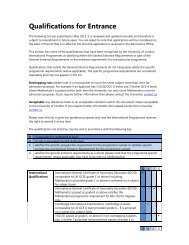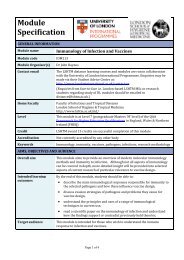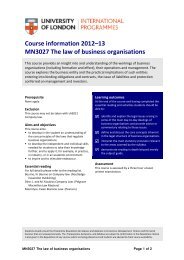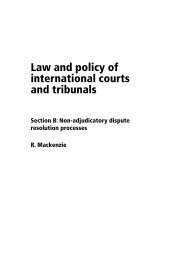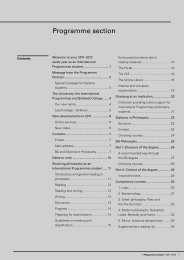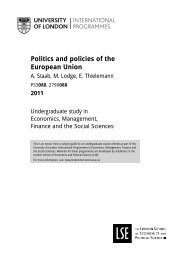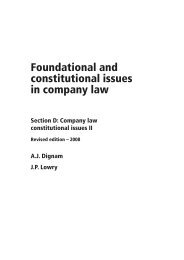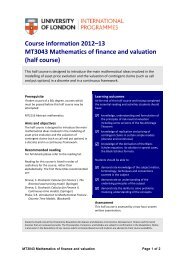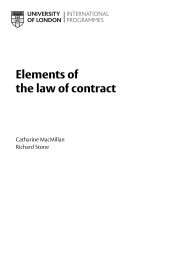Public law - University of London International Programmes
Public law - University of London International Programmes
Public law - University of London International Programmes
You also want an ePaper? Increase the reach of your titles
YUMPU automatically turns print PDFs into web optimized ePapers that Google loves.
page 44 <strong>University</strong> <strong>of</strong> <strong>London</strong> <strong>International</strong> <strong>Programmes</strong><br />
You should be alert to the concept <strong>of</strong> separation <strong>of</strong> powers throughout your study <strong>of</strong><br />
this course, where examples <strong>of</strong> separation <strong>of</strong> powers are presented. When considering<br />
sovereignty, for example, you should be aware that the sphere <strong>of</strong> power conceded<br />
to Parliament to enact <strong>law</strong>s, to regulate its own procedure, etc. is a clear, if implicit,<br />
example <strong>of</strong> separation <strong>of</strong> powers. Equally so is the cautious judicial attitude to<br />
questioning the exercise <strong>of</strong> the royal prerogative and the courts’ attitudes to the<br />
privileges <strong>of</strong> Parliament. Furthermore, the Human Rights Act 1998 has had a significant<br />
impact on the separation <strong>of</strong> powers. See Chapter 15 for further details.<br />
The attitudes <strong>of</strong> some academics and judges to the separation <strong>of</strong> powers differ markedly<br />
(see for example the dictum <strong>of</strong> Lord Diplock in Duport Steels Ltd v Sirs [1980] 1 WLR 142, at<br />
p.157).<br />
Activities 4.3–4.5<br />
4.3 To what extent is separation <strong>of</strong> powers:<br />
a. evident and<br />
b. desirable under the constitution?<br />
4.4 What is the explanation for the apparent conflict between judges and some<br />
academics? Are these two views capable <strong>of</strong> being reconciled?<br />
4.5 Critically assess the statutory provisions and constitutional conventions that<br />
support the concept <strong>of</strong> separation <strong>of</strong> powers.<br />
Self-assessment questions<br />
1. What are the three ‘organs <strong>of</strong> government’ whose powers need to be separated?<br />
2. Within the British state, what constitutes the executive?<br />
3. What did the Act <strong>of</strong> Settlement 1700 do for the position <strong>of</strong> judges in higher<br />
courts?<br />
4. Why, in 1999, was the decision to extradite General Pinochet set aside?<br />
5. What was the significance <strong>of</strong> the case <strong>of</strong> M v Home Office (1994)?<br />
Summary<br />
The role <strong>of</strong> conventions in relation to the separation <strong>of</strong> powers is critical. Examining<br />
the relationships and identifying overlaps reveals only half the constitutional picture.<br />
Therefore, in order to gain a full understanding, attention must be paid to the<br />
conventional rules.<br />
Sample examination questions<br />
Question 1 ‘Our unwritten constitution rests upon a separation <strong>of</strong> powers. It also<br />
rests upon a mutual recognition <strong>of</strong> those powers. It is for Parliament to make new<br />
<strong>law</strong>s and to amend old <strong>law</strong>s, including the common <strong>law</strong>. It is for the courts to interpret<br />
and enforce the <strong>law</strong>. It is for the government to govern within the <strong>law</strong>. Each in<br />
its own sphere is supreme.’ (Lord Donaldson <strong>of</strong> Lymington MR in M v Home Office and<br />
Another (1994).) Discuss.<br />
Question 2 Critically assess the view, expressed by Walter Bagehot in the nineteenth<br />
century, that the ‘near fusion’ <strong>of</strong> the executive and legislature represents the<br />
‘efficient secret’ <strong>of</strong> the constitution.<br />
Advice on answering the questions<br />
Question 1 This quotation spans all three <strong>of</strong> the major institutions <strong>of</strong> the state,<br />
and requires an analysis <strong>of</strong> the role and powers <strong>of</strong> each. It also calls for a critical<br />
examination <strong>of</strong> the degree <strong>of</strong> separation between them. Start by explaining what<br />
the separation <strong>of</strong> powers means and explain its constitutional importance – perhaps<br />
pointing out that it is a concept <strong>of</strong> great antiquity. The next task is to explain briefly the<br />
role <strong>of</strong> each <strong>of</strong> the major institutions <strong>of</strong> the state: the personnel and functions <strong>of</strong> each.




